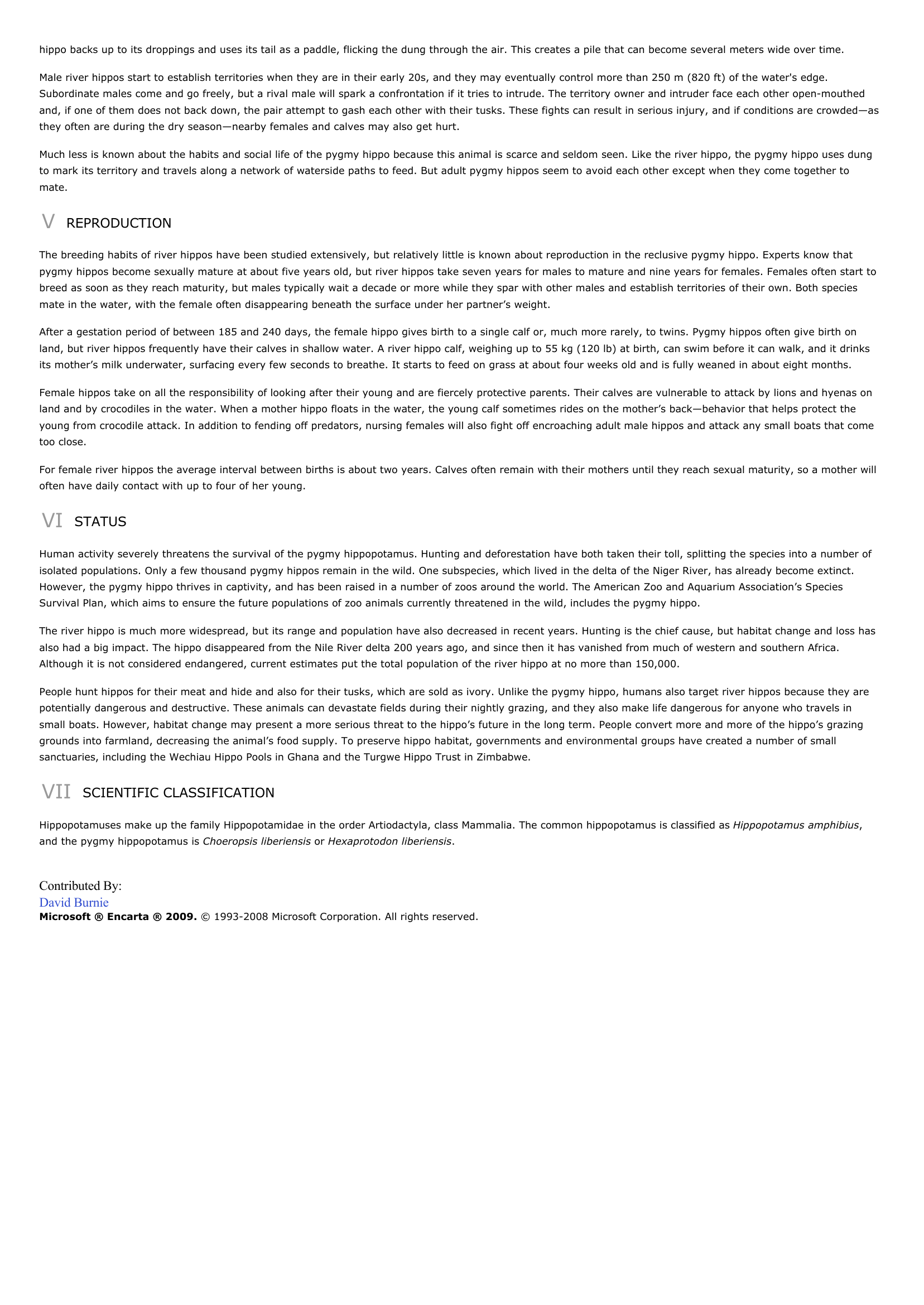Hippopotamus - biology.
Publié le 11/05/2013

Extrait du document
«
hippo backs up to its droppings and uses its tail as a paddle, flicking the dung through the air.
This creates a pile that can become several meters wide over time.
Male river hippos start to establish territories when they are in their early 20s, and they may eventually control more than 250 m (820 ft) of the water's edge.Subordinate males come and go freely, but a rival male will spark a confrontation if it tries to intrude.
The territory owner and intruder face each other open-mouthedand, if one of them does not back down, the pair attempt to gash each other with their tusks.
These fights can result in serious injury, and if conditions are crowded—asthey often are during the dry season—nearby females and calves may also get hurt.
Much less is known about the habits and social life of the pygmy hippo because this animal is scarce and seldom seen.
Like the river hippo, the pygmy hippo uses dungto mark its territory and travels along a network of waterside paths to feed.
But adult pygmy hippos seem to avoid each other except when they come together tomate.
V REPRODUCTION
The breeding habits of river hippos have been studied extensively, but relatively little is known about reproduction in the reclusive pygmy hippo.
Experts know thatpygmy hippos become sexually mature at about five years old, but river hippos take seven years for males to mature and nine years for females.
Females often start tobreed as soon as they reach maturity, but males typically wait a decade or more while they spar with other males and establish territories of their own.
Both speciesmate in the water, with the female often disappearing beneath the surface under her partner’s weight.
After a gestation period of between 185 and 240 days, the female hippo gives birth to a single calf or, much more rarely, to twins.
Pygmy hippos often give birth onland, but river hippos frequently have their calves in shallow water.
A river hippo calf, weighing up to 55 kg (120 lb) at birth, can swim before it can walk, and it drinksits mother’s milk underwater, surfacing every few seconds to breathe.
It starts to feed on grass at about four weeks old and is fully weaned in about eight months.
Female hippos take on all the responsibility of looking after their young and are fiercely protective parents.
Their calves are vulnerable to attack by lions and hyenas onland and by crocodiles in the water.
When a mother hippo floats in the water, the young calf sometimes rides on the mother’s back—behavior that helps protect theyoung from crocodile attack.
In addition to fending off predators, nursing females will also fight off encroaching adult male hippos and attack any small boats that cometoo close.
For female river hippos the average interval between births is about two years.
Calves often remain with their mothers until they reach sexual maturity, so a mother willoften have daily contact with up to four of her young.
VI STATUS
Human activity severely threatens the survival of the pygmy hippopotamus.
Hunting and deforestation have both taken their toll, splitting the species into a number ofisolated populations.
Only a few thousand pygmy hippos remain in the wild.
One subspecies, which lived in the delta of the Niger River, has already become extinct.However, the pygmy hippo thrives in captivity, and has been raised in a number of zoos around the world.
The American Zoo and Aquarium Association’s SpeciesSurvival Plan, which aims to ensure the future populations of zoo animals currently threatened in the wild, includes the pygmy hippo.
The river hippo is much more widespread, but its range and population have also decreased in recent years.
Hunting is the chief cause, but habitat change and loss hasalso had a big impact.
The hippo disappeared from the Nile River delta 200 years ago, and since then it has vanished from much of western and southern Africa.Although it is not considered endangered, current estimates put the total population of the river hippo at no more than 150,000.
People hunt hippos for their meat and hide and also for their tusks, which are sold as ivory.
Unlike the pygmy hippo, humans also target river hippos because they arepotentially dangerous and destructive.
These animals can devastate fields during their nightly grazing, and they also make life dangerous for anyone who travels insmall boats.
However, habitat change may present a more serious threat to the hippo’s future in the long term.
People convert more and more of the hippo’s grazinggrounds into farmland, decreasing the animal’s food supply.
To preserve hippo habitat, governments and environmental groups have created a number of smallsanctuaries, including the Wechiau Hippo Pools in Ghana and the Turgwe Hippo Trust in Zimbabwe.
VII SCIENTIFIC CLASSIFICATION
Hippopotamuses make up the family Hippopotamidae in the order Artiodactyla, class Mammalia.
The common hippopotamus is classified as Hippopotamus amphibius , and the pygmy hippopotamus is Choeropsis liberiensis or Hexaprotodon liberiensis .
Contributed By:David BurnieMicrosoft ® Encarta ® 2009. © 1993-2008 Microsoft Corporation.
All rights reserved..
»
↓↓↓ APERÇU DU DOCUMENT ↓↓↓


